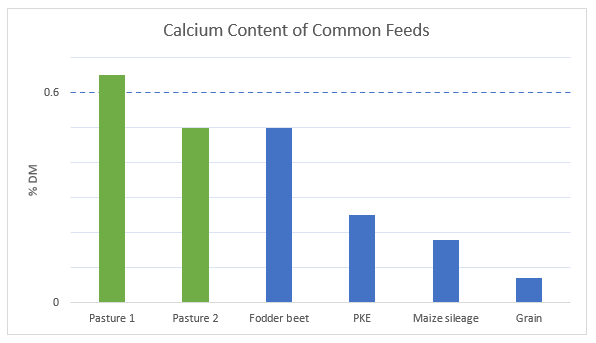Is calcium supplementation a “spring only” thing?
The mention of calcium will, for many of us, bring to mind milk fever, metabolic bags and rain. It is around the time of calving where the issues surrounding calcium in the dairy cow become most visible to us. So, it might seem odd discussing calcium requirements outside spring.
Calcium is vastly important for vital organ function, production, reproduction and immunity. As such, deficiency can result in reduced production, poor reproductive performance, increased chance of infection (such as mastitis and metritis) and death.
Calcium demand increases around calving – colostrum contains twice as much calcium as milk and the late-gestation foetus has high calcium demands. The process of calving requires a lot of muscular activity which also demands calcium. All the while the cow reduces her feed intake and so delves into her stores (hopefully!) of skeletal calcium.
So why are we discussing calcium now? Well, calcium supply is not solely a spring concern but needs to be considered all season. If bone reserves are depleted during the season, milk fever cases at subsequent calvings could reach high numbers despite good springer management. Not only that, subclinical milk fever will impact production, reproduction and animal health.
A total pasture diet typically provides most, if not all, calcium required by a milking cow (approx. 0.6% of dry matter). Be aware that pasture calcium content can vary between paddocks and will vary over time also. Supplementary feeds often have dramatically lower calcium concentrations compared to pasture, as illustrated in the graph below:
Figure 1 – Calcium content of various feeds as a percentage of dry matter. Dotted line indicates dietary calcium requirements for a milking cow.
The following graph compares the calcium content of 6 different diets – simplified to 20kgDM offered and using typical feed calcium values.
Figure 2 – Diets compared to milking cow requirements (~120g per day) and colostrum cow requirements (~150g per day).
For herds consuming low calcium diets, additional calcium will be pulled from skeletal stores, slowly depleting reserves. Aside from production and health implications, these herds often experience high numbers of milk fever cases at calving. If you feel that you are constantly tweaking the springer diet/management without success, and no matter what you do the mature cows have a high rate of milk fever – then mid-lactation could be a good time to rethink the issue of calcium in the herd.
It is a reality for many of our clients that calcium supplementation should be continued for much of the season. This is an added cost and can be time consuming if dusting is the only method available. But if making sure your herd is getting their required minerals for optimal production and health is important to you, then it is worthwhile supplementing whenever necessary.
If you have more than 3% of the herd treated for milk fever in the spring, or feel you have too many assisted calvings, high rates of RFMs and mericheck-positive cows, then it is worth reviewing the calcium intake of your herd. Get in contact with us to organise a review of the calcium requirements of your herd.


